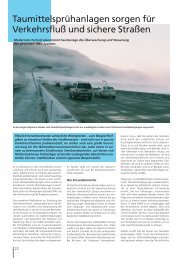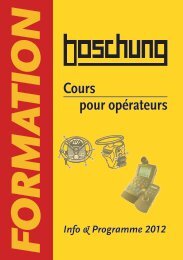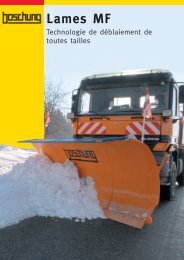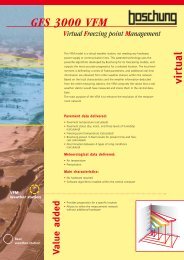Physical bases of freezing point measurement using ... - Boschung
Physical bases of freezing point measurement using ... - Boschung
Physical bases of freezing point measurement using ... - Boschung
You also want an ePaper? Increase the reach of your titles
YUMPU automatically turns print PDFs into web optimized ePapers that Google loves.
Proceedings <strong>of</strong> the 9 th SIRWEC Conference 15-17 March 1998, Luleå, Sweden 282<br />
eopt , which is rather weak, is represented in figure 7.<br />
e opt [mm]<br />
0.16<br />
0.14<br />
0.12<br />
0.10<br />
0.08<br />
0.06<br />
0.04<br />
0.02<br />
0.00<br />
Figure 7 : dependence <strong>of</strong> eopt on s.<br />
0 10 20 30 40<br />
s [g/m 2 ]<br />
Knowing e and Ts, the salt content can be calculated by :<br />
cT ( s)<br />
⋅ e<br />
s =<br />
ν<br />
( cT ( ) )<br />
where c(Ts) is approximated by the following polynomial :<br />
s<br />
, (13)<br />
−63−42−2 cT ( ) =−6. 211⋅10 ⋅T −4. 637 ⋅10 ⋅T −1807 . ⋅10 ⋅T<br />
s s s<br />
4.3 Accuracy <strong>of</strong> the <strong>measurement</strong> <strong>of</strong> the <strong>freezing</strong> temperature<br />
s<br />
. (14)<br />
While the accuracy <strong>of</strong> the <strong>measurement</strong> <strong>of</strong> Ts by an active probe is mostly given by the<br />
accuracy ΔT <strong>of</strong> the sensor which measures the temperature during the cooling, the one <strong>of</strong> a<br />
passive probe is dependent <strong>of</strong> the function T = T( x , x , x , K, x , K , x ) used to compute<br />
s s 1 2 3 i n<br />
the <strong>freezing</strong> temperature. In that case, the absolute error is given by :<br />
ΔT<br />
s ≅<br />
i=<br />
1<br />
n<br />
Ts<br />
∑ x<br />
∂<br />
∂<br />
i<br />
Δ x , (15)<br />
where the xi are the different variables which are measured and Δxi their absolute errors. In<br />
other words, the accuracy <strong>of</strong> a passive probe is a sum <strong>of</strong> errors depending <strong>of</strong> the different<br />
parameters themselves and their absolute error. If for instance a passive probe is able to<br />
measure the salt concentration and the thickness <strong>of</strong> the solution, it can be understood that<br />
errors on c and e (due to the <strong>measurement</strong>s themselves, pollutants, etc.) will affect the<br />
i
















